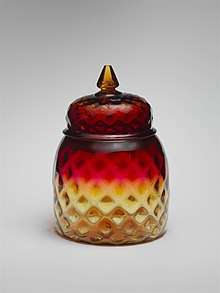New England Glass Company

%2C_by_Centennial_Photographic_Co._2.jpg)
The New England Glass Company (1818–1878), originally founded in Cambridge, Massachusetts and subsequently relocated to Toledo, Ohio, was established by "Amos Binney, Edmund Munroe, Daniel Hastings, and Deming Jarves on February 16, 1818. It was renamed the Libbey Glass Company in 1892, then was bought (in 1935) by Owens-Illinois Glass Company, which spun it off as an independent company in 1993. The company produced both blown and pressed glass objects in a variety of colors, which had engraved, cut, etched, and gilded decorations. The firm was one of the first glass companies to use a steam engine to operate its cutting machines, and it built the only oven in the country that could manufacture red lead, a key ingredient in the making of flint glass. By the middle of the nineteenth century, the New England Glass Company was considered one of the leading glasshouses in the United States, best known for its cut and engraved glass.".[1][2][3]
At its start, the company occupied a disused East Cambridge warehouse erected by the recently failed Boston Porcelain and Glass Company. It was fitted with two flint furnaces, 24 steam-operated glass-cutting mills, and a red-lead furnace, which in combination could produce many types of plain, molded, and cut glass. The company charter permitted it to manufacture "flint and crown glass of all kinds in the towns of Boston and Cambridge." At that time, about 40 glass factories existed in the United States, though most had few employees. Deming Jarves held one key advantage over his competitors in the glass manufacturing business; he held the American monopoly on red lead (lithage), which was essential for the production of fine lead glass. In 1826, however, Jarves left to found the Boston and Sandwich Glass Company.
Through the 1820s, the company exhibited at the American Institute Fair, won a Franklin Institute award for "skill and ingenuity," and established agencies in New York, Philadelphia, and Baltimore. The company took full advantage of the introduction of pressed glass and its business grew rapidly. Within 25 years, the glass industry was Cambridge's top employer in 1845 and again in 1855, when two companies, New England and Bay State, each employed more than 500 people. Engraver Louis F. Vaupel (1824 - 1903), who joined New England Glass in 1856, led its creation in the 1860s and 1870s of high-quality cut and engraved products, including very fine paperweights.
The company flourished as one of America's leading glass manufacturers through the Civil War, but the development of inexpensive soda-lime glass in West Virginia brought a deep decline in sales, which dropped from about $500,000 in 1865 to $232,304 in 1876, when the workforce had been reduced to only 200 laborers. In 1877, the company's directors withdrew from active participation, leasing the property to William Libbey, their agent since 1870.
"William L. Libbey took over the company in 1878 and renamed it the New England Glass Works, Wm. L. Libbey & Sons Props. In 1888 Edward Drummond Libbey moved the company to Toledo, Ohio. In 1892, the name was changed to The Libbey Glass Company"[4] and the company became part of Libbey-Owens-Ford for a number of years. Libbey Glass Company was acquired by Owens-Illinois Glass Company in 1935, but in 1993 it was once again spun off as an independent company, which it remains today.
Galleries
The manufacture
 Exterior view of the New England Glass Company from the east, c.1855.
Exterior view of the New England Glass Company from the east, c.1855. The glassblowing department of the New England Glass Company, c.1855.
The glassblowing department of the New England Glass Company, c.1855. Glass-cutting room of the New England Glass Company, c.1855.
Glass-cutting room of the New England Glass Company, c.1855. Showroom of the New England Glass Company, c.1855.
Showroom of the New England Glass Company, c.1855.
Creations
 Sugar bowl and cream pitcher, free-blown glass with applied decoration, 1815-1835
Sugar bowl and cream pitcher, free-blown glass with applied decoration, 1815-1835 Cream pitcher, pressed glass, 1827–35
Cream pitcher, pressed glass, 1827–35 Oil Lamp, pressed and free-blown white opaque glass, 1830-1840
Oil Lamp, pressed and free-blown white opaque glass, 1830-1840 Kerosene Table Lamp, ca 1850
Kerosene Table Lamp, ca 1850 Girandole, cased and cut blown and engraved glass, 1850-1860
Girandole, cased and cut blown and engraved glass, 1850-1860 Seal, 1850-1870
Seal, 1850-1870 Vase with witch ball, blown glass, 1850-1875
Vase with witch ball, blown glass, 1850-1875 Wine glass, blown glass, 1850-80
Wine glass, blown glass, 1850-80 Compote, red-cut-to-clear-glass, 1855–70
Compote, red-cut-to-clear-glass, 1855–70 Hat stand, free-blown silvered glass, 1855-1875
Hat stand, free-blown silvered glass, 1855-1875 Perfume decanter, green cased over colorless lead glass, 1866–70
Perfume decanter, green cased over colorless lead glass, 1866–70 "Wild Rose" Lily vase, blown glass, ca 1886
"Wild Rose" Lily vase, blown glass, ca 1886 Covered jar, blown Amberina glass, 1883-1888
Covered jar, blown Amberina glass, 1883-1888
References
- ↑ Laura Cotton. The fancy paperweights of the New England Glass Company. The Magazine Antiques, 1 Oct 2006. Vol.170, Iss.4
- ↑ Gordon Campbell, ed. Grove encyclopedia of decorative arts. Oxford University Press US, 2006.
- ↑ John Hayward. The New England gazetteer. O. Clapp, 1857.
- ↑ Libbey.com
External links
| Wikimedia Commons has media related to New England Glass Company. |
- "A City Built of Glass". The University of Toledo Libraries. 3 January 2012. Retrieved 8 June 2014.
- "Plain Glass to Artistry: A History of the New England Glass Company". Cambridge Historical Society. Cambridge Historical Society. Archived from the original on 11 December 2010. Retrieved 8 June 2014.
- Collections search for objects created by the New England Glass Co., Museum of Fine Arts, Boston. Retrieved 8 June 2014.
- "New England Glass Company Boston & Sandwich Company". American Manufacturers. Illinois State Museum Society. 2002. Retrieved 8 June 2014.
- "The New England Glass Company, 1818-1888". The Toledo Museum of Art. 1963. Retrieved 10 August 2014.